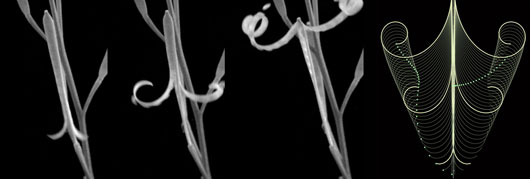Unlike animals, plants don’t have muscles to move their organs. So rapid movements, like exploding seed pods, are rare in the plant kingdom. Two HFSP-funded groups in the Department of Comparative Development and Genetics at the Max Planck Institute for Plant Breeding Research, Cologne, worked together with scientists from different disciplines to discover how the seed pods of popping cress explode.
This movement is so fast that advanced high-speed cameras are needed even to see the seed pod coiling (Fig. 1). The seeds are accelerated away from the pod and get up-to-speed extremely quickly: from 0 to 10 metres per second in half a millisecond. The interdisciplinary team discovered that the secret to explosive acceleration in popping cress is the evolutionary innovation of a fruit wall that can store elastic energy through growth and expansion, and rapidly release this energy at the right stage of development.

Figure 1. Explosive coiling of the seed pod is used by popping cress (Cardamine hirsuta) to disperse its seeds. This dynamic process is recapitulated in a multi-scale model. Credit A. Hay, MPIPZ.
This challenged the established view that tension builds passively in the seed pod by differential contraction of the pod walls as they dry. This explanation puzzled the team because popping cress pods exploded while hydrated, rather than dry. Their surprising discovery was that hydrated cells in the outer layer of the pod walls actually used their internal pressure in order to contract and generate tension. Using a computational model of three-dimensional plant cells (Fig. 2), they showed that when these cells were pressurized, they expanded in depth while contracting in length; like the way an air mattress expands in depth, when inflated, but contracts in width.

Figure 2. Physically-based finite element model of pressurized cells. In this simulation we used the model to measure the tension generated by the cells as they expand. Heatmap shows stress in MPa. Credit G. Mosca, MPIPZ.
Another unexpected finding was how the elastic energy stored in the seed pod was released. At maturity, the wall of the seed pod needs to coil along its length to release tension, but it has a curved cross-section preventing this. This geometric constraint is also found in a toy called a slap bracelet. In both the toy and the seed pod, the cross-section first has to flatten before the tension is suddenly released by coiling. Unexpectedly, this mechanism relies on the geometry of asymmetric secondary cell wall thickenings in the seed pod. These stiff cells' walls are shaped like hinges, which can open. This flattens the cross-section of the seed pod wall, causing sudden mechanical failure of the structure and explosive coiling.
This study is an example of how HFSP funding of interdisciplinary, collaborative science can lead to a global understanding of the biological and physical mechanisms at play in a complex process. To build up a comprehensive picture of explosive seed dispersal, this team related observations at the plant scale all the way down to the cellular and genetic scales, and systematically linked each scale. This approach was only made possible by combining state-of-the-art modelling techniques with biophysical measurements and biological experiments.
Reference
Morphomechanical innovation drives explosive seed dispersal. Hofhuis H*, Moulton D*, Lessinnes T*, Routier-Kierzkowska A*, Bomphrey RJ*, Mosca G, Reinhardt H, Sarchet P, Gan X, Tsiantis M, Ventikos Y, Walker S, Goriely A, Smith R, Hay A. (2016) Cell 166, 222-33 * Co-first authors
Open access article and video at ScienceDirect
Cell Preview: Actuators Acting without Actin
Max Planck Society Research News
News from the Mathematical Institute, University of Oxford


































